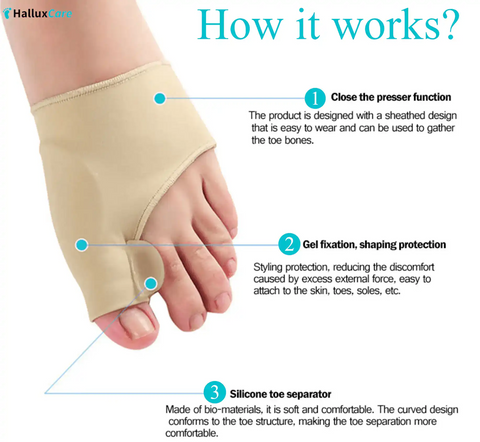Bunion Tattoos: A Painful Cover-Up or a Regrettable Decision?
Last Updated: June 2024
Medically Reviewed by: [Your Name], DPM – Board-Certified Podiatrist
Key Takeaways
- Bunion tattoos are extremely painful due to the thin skin and proximity to bone.
- Distortion is likely as bunions change shape over time or after surgery.
- Healing is challenging because the foot endures constant friction and pressure.
- Non-invasive solutions, such as bunion correction sleeves, provide pain relief and preventive care.
- Medical professionals discourage tattoos over bunions due to health risks and potential complications.
Why People Consider a Bunion Tattoo
A bunion, or hallux valgus, is a bony bump that forms at the base of the big toe due to improper foot mechanics, genetics, or prolonged pressure from tight shoes. Some individuals consider tattooing over a bunion for the following reasons:
- Aesthetic concerns – Bunions can be visually unappealing, and a tattoo might seem like a creative way to cover them.
- Self-confidence boost – Covering an imperfection with body art may help some feel more comfortable in open-toed shoes.
- Symbolism – Some people use tattoos to mark personal milestones, including overcoming insecurities.
However, before proceeding, it’s crucial to understand the medical and practical risks of tattooing over a bunion.
The Reality of Tattooing Over a Bunion
1. Extreme Pain
Tattooing over a bunion is significantly more painful than other body parts due to:
- Thin skin and lack of fat padding – The skin over a bunion is stretched tightly over bone, offering little cushion for the tattoo needle.
- High nerve density – The foot contains numerous nerve endings, making the pain more intense.
According to the American Academy of Dermatology (AAD), tattoos on bony areas tend to cause higher discomfort and prolonged healing issues.
2. Distortion Over Time
- Bunions worsen with time, meaning the tattoo may stretch and deform.
- If you opt for bunion surgery, the structure of your foot will change, potentially leaving the tattoo unrecognizable.
3. Healing Challenges
Unlike tattoos on arms or legs, foot tattoos are prone to complications:
- Constant friction from socks and shoes can interfere with proper healing.
- Swelling and irritation may prolong recovery, increasing the risk of infection.
- Delayed ink absorption – The foot receives less blood flow compared to other areas, often leading to fading or patchy healing.
4. Unwanted Attention
Rather than disguising the bunion, a tattoo may draw more attention to the area.
- A colorful or dark design can highlight the irregular shape instead of concealing it.
- People unfamiliar with bunions may ask uncomfortable questions about the tattoo’s meaning.
Dr. Karen Langone, DPM, a podiatrist certified by the American Board of Podiatric Medicine, warns:
“A bunion tattoo could not only cause pain but also lead to delayed healing, infections, and long-term regrets due to distortion. It’s not a recommended choice.”
Are There Better Alternatives?
If your goal is to reduce bunion pain and improve foot appearance, consider non-invasive solutions before opting for a tattoo.
1. Bunion Correction Sleeves
A bunion correction sleeve provides gentle realignment of the toe while reducing discomfort.
4.9 ⭐⭐⭐⭐⭐ ( 1843 reviews )
2. Proper Footwear
Wearing the right shoes can prevent bunions from worsening:
- Choose wide-toe box shoes to reduce pressure.
- Avoid high heels and narrow shoes, which place strain on the toe joint.
3. Orthopedic Inserts
Custom or over-the-counter orthotic insoles can:
- Improve foot alignment.
- Distribute weight evenly, reducing pressure on the bunion.
4. Non-Surgical Treatments
- Stretching exercises – Help maintain toe flexibility and relieve stiffness.
- Pain-relief creams & essential oils – Jamaican Black Castor Oil is known for its anti-inflammatory benefits.
Final Thoughts: Is a Bunion Tattoo Worth It?
While a tattoo might seem like an artistic solution, the pain, distortion, and healing difficulties make it an impractical choice for most people.
Instead of covering up the problem, consider addressing it with orthopedic solutions that provide long-term relief.
Would you ever consider getting a tattoo over a bunion? Let us know in the comments!
FAQs
1. Can I get a tattoo over a bunion if I plan on having surgery later?
It’s not recommended. Bunion surgery alters the shape of the foot, potentially warping the tattoo beyond recognition.
2. How painful is a bunion tattoo compared to regular foot tattoos?
Bunion tattoos are significantly more painful due to the thin skin and proximity to bone.
3. Will the tattoo cover the bunion completely?
A tattoo may not fully disguise a bunion’s shape. Instead, it may accentuate the bump, drawing more attention to it.
4. What are safer alternatives to bunion tattoos?
Consider bunion correction sleeves, proper footwear, and orthopedic inserts to manage bunion pain and appearance.
Recommended Bunion Care Products
- Orthopedic Bunion Pain Relief & Correction Sleeve – Helps with realignment and pain reduction.
- Tailor’s Bunion Bunionette Protection Sleeves – Provides targeted relief for tailor’s bunions.
- Jamaican Black Castor Oil Soothing Oil – Reduces inflammation and promotes skin hydration.
Disclaimer: This article is for informational purposes only and is not a substitute for professional medical advice. Always consult a board-certified podiatrist before making decisions about bunion treatment or tattoos.




